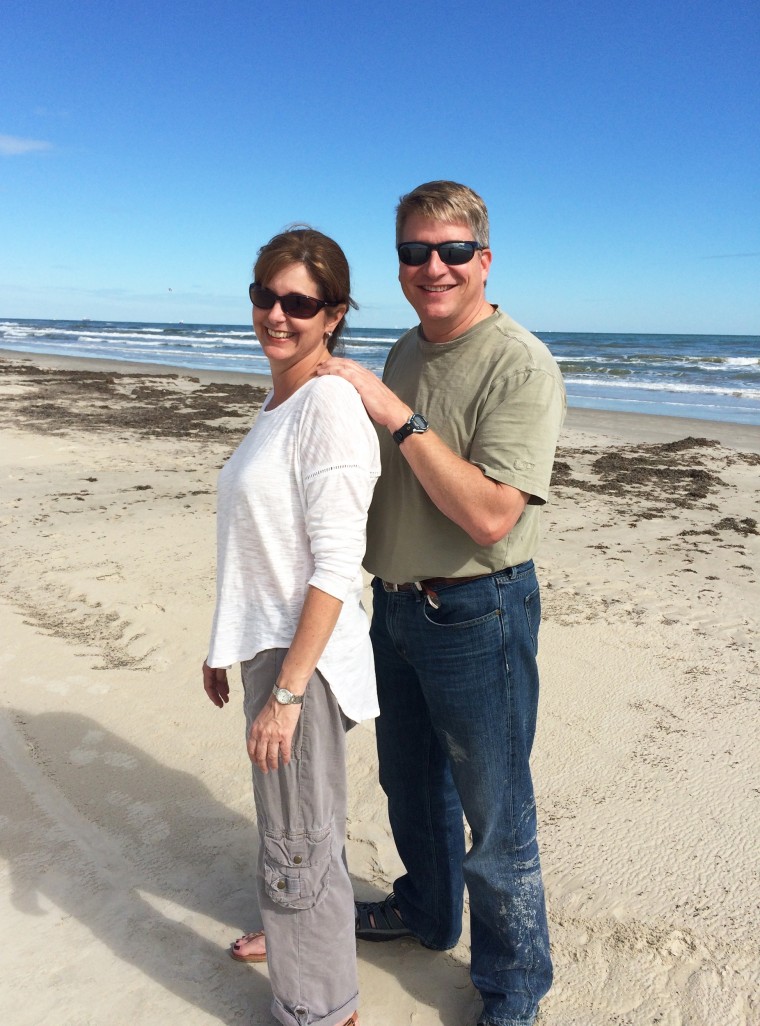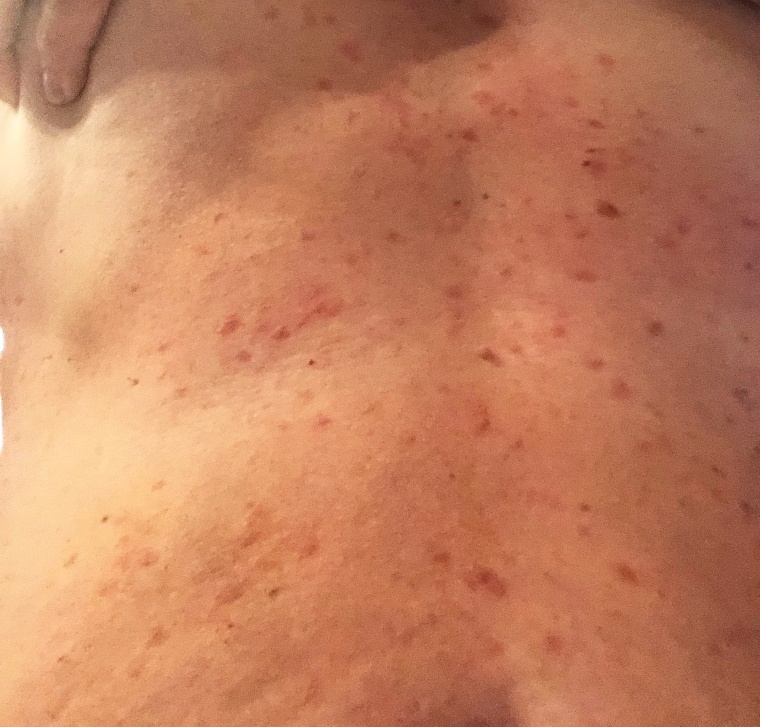Several years ago, Jill Zinsmeyer was visiting Texas when fire ants bit her and she lost consciousness for 45 minutes. When she woke in the hospital, she knew something was seriously wrong.

“I thought it was just an extreme allergy to fire ant bites,” Zinsmeyer, 57, of Austin, tells TODAY.com. “There was no reason to expect that there was anything other than just some serious allergies.”But she'd also been noticing other strange things going on with her body and wondered if they were connected to the extreme reaction to the fire ant bites.
For example, Zinsmeyer often developed a brown bumpy rash when she underwent a temperature change, such as stepping out of a hot tub. She also experienced bouts of unexplained moodiness, struggled with activities in the heat and often felt exhausted.
She visited numerous doctors to understand what was happening. Several doctors dismissed her.
After eight years, she was diagnosed with systemic mastocytosis, a rare condition that can cause a slew of symptoms, including extreme allergic reactions, emotional distress, dizziness, gastrointestinal troubles and more, according to American Academy of Allergy Asthma and Immunology.
“If you think somethings wrong, don’t let physicians push you aside or make you feel like you’re crazy or insignificant,” she says. “Push until you meet the right provider that listens.”
Extreme allergic reactions, burning rash
About 10 years ago, Zinsmeyer noticed that she'd develop a rash on her abdomen when her body experienced temperature changes. A burning sensation accompanied brown bumps, but everything went away after 20 to 30 minutes. She thought it was odd but not worrisome.
“That was just peculiar, and I didn’t think too much of it. When it would come up, I’d just be like, ‘I wonder what’s causing that,’” Zinsmeyer recalls.
Meanwhile, she also noticed she "was really sensitive to bee stings, any kind of flying insect that stings." While she never got close to anaphylaxis, when an allergic reaction turns life-threatening, she says her body's reaction to insect stings seemed "extreme."
For example, when she started visiting Texas to spend time with her now-husband, she encountered fire ants, an insect she didn’t see much in Napa Valley, California, where she was living. The first time a fire ant bit her, she experienced tingling in her hands and feet.
“It was so slight,” she says. “It felt like maybe I was just imagining it.”
She took Benadryl and the tingling went away. Then, fire ants bit her again and she noticed the tingling the second time. The third time she encountered the insects, she got four bites at once and fainted.
“(I) was unconscious within five minutes,” she says. “I woke up in the emergency room. It was probably 45 minutes to an hour after the actual bite.”
Given her expertise as a registered nurse, Zinsmeyer surmised that she had an unusual allergy to fire-ant bites. She started visiting an allergist, who suggested allergy shots for fire-ant bites, but she didn’t respond well to the shots. She felt the same tingling in her hands and feet as what followed the first fire-ant incident.
"(The doctor) didn’t take it seriously,” Zinsmeyer says. “He thought I was imagining it.”
Frustrated, she visited another allergist, who conducted blood tests to look at her levels of tryptase, a protein that elevates when a person has an allergic reaction but normally returns to baseline within 48 hours.
“It came back a little more than about three times where it (was) supposed to be,” she says, adding that this was weeks after she passed out.
So, she turned to Google. “I started connecting the dots on my own,” she says.

She visited several more doctors. She says one doctor put her through “a battery of really bizarre tests,” including heating something in the microwave and putting it on her skin to see if it reddened.
“(He) did not want to hear that I Googled my symptoms and came up with my own diagnosis,” she says.
Zinsmeyer eventually found a dermatologist who encouraged her to undergo a bone marrow biopsy to test for systemic mastocytosis.
“I got the positive diagnosis,” she says.
Systemic mastocytosis
Systemic mastocytosis occurs when mast cells — white blood cells that live in bone marrow and other organs and help the immune system function properly — multiply due to a gene mutation that develops over a person's life, Dr. Prithviraj Bose, professor in the department of leukemia at MD Anderson Cancer Center, tells TODAY.com.
When mast cells build up in the body and something happens to trigger them, like drinking alcohol or an insect sting, they can cause allergic reaction-like symptoms or extreme inflammation, which can result in organ damage, according to Mayo Clinic.
Because patients experience a variety of symptoms in different organs, diagnosis can be complicated.
“People can have brain fog, dizziness, headaches, respiratory symptoms. You can have skin rash, itching, flushing spots, nausea, vomiting, abdominal pain, diarrhea, muscle issues, like muscle weakness. It can affect bone density,” Bose says. “It’s a wide variety of symptoms that patients can be faced with.”
He adds: “The problem is that (the symptoms) could be attributed to something else, or it may not be on the (doctor’s) radar. Patients can go years without an actual diagnosis.”
While delayed diagnosis doesn’t seem to impact lifespan, it certain affects people quality of life.
“It prolongs people’s suffering,” Bose says. “In extreme cases people can be homebound.”
For treatment, patients often take a class of medications called antimediator drugs, which help stabilize the mast cells. For some patients, like Zinsmeyer, these therapies don’t work well.
When Bose first met Zinsmeyer, she was taking three medications, but she still struggled with symptoms, like swelling, itching and fatigue.
“It was clear that she continued to have problems,” he says.

Bose was an investigator in a clinical trial for a medication to treat systemic mastocytosis called Ayvakit. Zinsmeyer joined, and since then, the U.S. Food and Drug Administration has approved the medication for people with advanced and indolent (less severe) systemic mastocytosis. The medication has worked well for her, and she no longer has a reaction when she experiences a trigger.
Having a diagnosis and treatment
When Zinsmeyer first started in the clinical trial, she didn’t notice any difference. She still felt exhausted and experienced rashes when the temperature changed. Soon, though, she experienced relief.
“After the second cycle of actually being on the medication, I started to notice improvements,” she says. “I wasn’t as tired during the day. I could function.”
Prior to treatment, she struggled with Texas’s warm weather. On 95-degree days, even taking groceries inside felt overwhelming and she’d need to nap. Now, she’s not as bothered.
But she’s still wary of fire ants: “I’m very careful — and I’m not willing to experiment,” she says.
Zinsmeyer shared her story to raise awareness of this condition so that others don’t face such a long diagnostic delay or being dismissed.
“There’s so many more of us out there that haven’t been diagnosed because the information isn’t out there — not only to the people with the condition but also to the providers who might see these people,” she says.